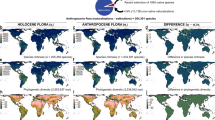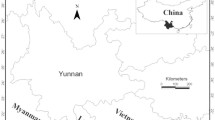Abstract
Identification of global biodiversity hotspots is a leading conservationpriority ( Hotspots.Conservation International, Washington, DC; Precious Heritage: The Statusof Biodiversity in the United States. Oxford University Press, Oxford, UK), but weknow little about the nature and structure of such hotspots. Botanical richnessin one recently identified hotspot, the California Floristic Province, has longbeen attributed by evolutionists to edaphic and climatic heterogeneity. Here we demonstrate that the flora restricted (endemic) toserpentine soil, the state's most botanically distinctive substrate, showsunusually high 'β diversity' – i.e., spatial variation inspecies composition – among regions, although 'α'diversity within any given region is low. Conservation of an endemic-rich florarequires a network of sites to capture this among-region or spatial component ofdiversity.
Similar content being viewed by others
References
Barbour M.G. and Major J. 1977. Terrestrial Vegetation of California. Wiley-Interscience, New York.
Brooks R.R. 1987. Serpentine and Its Vegetation: a Multidisciplinary Approach. Dioscorides Press, Portland, Oregon.
Brown J.H. 1988. Species diversity. In: Myers A.A. and Giller P.S. (eds), Analytical Biogeography. Chapman & Hall, New York, pp. 57–90.
Daly C., Neilson R.P. and Phillips D.L. 1994. A statistical–topographic model for mapping climatological precipitation over mountainous terrain. Journal of Applied Meteorology 3: 140–158.
Fortin M.-J. and Gurevitch J. 1993. Spatial structure in field experiments. In: Scheiner S.M. and Gurevitch J. (eds), Design and Analysis of Ecological Experiments. Chapman & Hall, New York, pp. 342–359.
Harrison S. 1997. How natural habitat patchiness affects the distribution of diversity in Californian serpentine chaparral. Ecology 78: 1898–1906.
Harrison S. 1999. Local and regional diversity in a patchy landscape: native, alien, and endemic herbs on serpentine soils. Ecology 80: 70–80.
Harrison S., Viers J.H. and Quinn J.F. 2000. Climatic and spatial patterns of diversity in the serpentine plants of California. Diversity and Distributions 6: 153–161.
Hickman J.C. (ed.) 1993. The Jepson Manual: Higher Plants of California. University of California Press, Berkeley, California.
Jennings C.W. 1977. Geologic Map of California. Geologic Data Series Map No. 2. California Division of Mines and Geology, Sacramento, California.
Kruckeberg A.R. 1954. The ecology of serpentine soils. III. Plant species in relation to serpentine soils. Ecology 35: 267–274.
Kruckeberg A.R. 1984. California Serpentines: Flora, Vegetation, Geology, Soils and Management Problems. University of California Press, Berkeley, California.
Kruckeberg A.R. 1991. An essay: geoedaphics and island biogeography for vascular plants. Aliso 13: 225–238.
MacArthur R.M. and Wilson E.O. 1967. The Theory of Island Biogeography. Princeton University Press, Princeton, New Jersey.
Manly B.F.J. 1997. Randomization, Bootstrap, and Monte Carlo Methods in Biology. Chapman & Hall, New York.
Mathsoft Corporation 1997. S-Plus 4.0. Mathsoft, Seattle, Washington.
Mayer M.S., Soltis P.S. and Soltis D.E. 1994. The evolution of the Streptanthus glandulosus complex (Cruciferae): genetic divergence and gene flow in serpentine endemics. American Journal of Botany 81: 1288–1299.
Mittermayer R.A., Mittermayer C.G. and Myers N. 1999. Hotspots. Conservation International, Washington, DC.
Raven P.H. 1964. Catastrophic selection and edaphic endemism. Evolution 18: 336–338.
Raven P.H. and Axelrod D.I. 1978. Origin and relationships of the California flora. University of California Publications in Botany 72: 1–134.
Richerson P.J. and Lum K.-L. 1980. Patterns of plant species diversity in California: relation to weather and topography. American Naturalist 116: 504–536.
Rosenzweig M.L. 1995 Species Diversity in Space and Time. Cambridge University Press, Cambridge, UK.
Stebbins G.L. 1942. The genetic approach to problems of rare and endemic species. Madroño 6: 241–272.
Stebbins G.L. and Hrusa G.F. 1995. The North Coast biodiversity arena in central California: a new scenario for research and teaching processes of evolution. Madroño 42: 269–294.
Stebbins G.L. and Major J. 1965. Endemism and speciation in the California flora. Ecological Monographs 35: 1–35.
Stein B.A., Kutner L.S. and Adams J.S. 2000. Precious Heritage: The Status of Biodiversity in the United States. Oxford University Press, Oxford, UK.
Walker R.E. 1992. Community models of species richness: regional variation of plant community species composition on the west slope of the Sierra Nevada, California, M.Sc. Thesis, University of California, Santa Barbara, California.
Whittaker R.H. 1954. The vegetational responses to serpentine soils. Ecology 35: 275–288.
Whittaker R.H. 1960.Vegetation of the Siskiyou Mountains, Oregon and California. Ecological Monographs 30: 279–338.
Author information
Authors and Affiliations
Rights and permissions
About this article
Cite this article
Harrison, S., Inouye, B.D. High β diversity in the flora of Californian serpentine 'islands'. Biodiversity and Conservation 11, 1869–1876 (2002). https://doi.org/10.1023/A:1020357904064
Issue Date:
DOI: https://doi.org/10.1023/A:1020357904064




